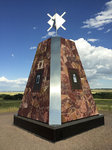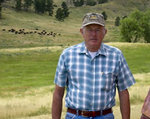

For years, Ted “T.R.” Hughes of Seward found ways to conserve native Nebraska history.
T.R. and his wife Kay were involved in a 15-year effort to build a memorial to the Northern Cheyenne who escaped from Fort Robinson. The memorial was dedicated this past summer.
Kay said T.R. became interested in Native American history and culture in eighth grade, when his history teacher had the class read “Crazy Horse” by Mari Sandoz.
“He was so taken with her,” Kay said. “Mari Sandoz really described both the Cheyenne and the Lakota as people with very interesting cultures. He really felt for what they had suffered in the face of Western expansion.”
Kay said Sandoz made that history come alive for T.R.
In 2009, T.R. was named the In the Spirit of Mari Sandoz Award recipient, which is given to those who “promote the understanding of Nebraska history and literature,” according to the Mari Sandoz Heritage Society website.
T.R.’s bio for the award, written by himself and Kay, states that T.R. was born May 1, 1938, in Seward, where he attended Seward Public Schools. He earned his bachelor’s degree in mechanical engineering from the University of Nebraska-Lincoln before returning to Seward to work in the engineering department of Hughes Brothers, Inc., a company T.R.’s father and two uncles started.
After T.R.’s father, Ted, died in 1962, T.R. became part owner of Hughes Brothers, and eventually purchased additional shares and became its president and the chairman of its board of directors.
Kay was born in Falls City and attended Concordia University for teacher training before attending UNL for graduate school in education administration. She taught in Milford as a substitute teacher for a year before she became the school’s library and media specialist, a position she held for 18 years.
T.R. and Kay were married in 1993 and T.R. retired in 1995 to pursue his interests in ranching, conservation and his work with the Northern Cheyenne until his death in March 2015,
Kay said T.R. became connected to the Cheyenne tribe, located in Montana, in the 1970s, when CU had a Center for Indian Ministries program.
Jerry Pfabe, who is currently a professor emeritus at CU, said this program, served on the program’s council from 1972 to 1984, when it existed. He said the program was a combination of providing support to Indian students on campus and providing ministry work on reservations.
That is how T.R. met Ted Rising Sun, who Pfabe said was supportive of CIM. Rising Sun was an elder of the Northern Cheyenne tribe and a great-grandson of Chief Dull Knife.
The Hugheses ranched near Crawford, where they raised genetically-pure bison, meaning they were not bred with cattle, and Spanish Barb horses. Kay said the bison herd grew from three heifer calves and a bull calf to roughly 200 animals over the years.
Kay said T.R. wanted to donate some of the excess bison to native tribes to begin their own herds. He got in touch with Rising Sun.
The two formed a close friendship. T.R. and Rising Sun adopted each other as brothers in the Cheyenne tradition in 1994.
“They were always talking about different projects,” Kay said, adding that they’d often speak on the phone for hours.
She said Rising Sun was involved in furthering Indian education, and he was a tribal historian.
Rising Sun told T.R. about the Fort Robinson Breakout, which took place in Crawford in 1879.
In 1876, after the Battle of Little Bighorn, the Cheyenne were forced to relocate from their home in Montana to what is now Oklahoma. Kay said the Cheyenne and the Lakota were the last tribes to hold out on the plains and fought the hardest to maintain their way of life.
In Oklahoma, the Cheyenne suffered.
“They were dying of diseases and starvation,” Kay said.
So Chief Dull Knife led an effort to bring the Cheyenne back home and the tribe left Oklahoma. But during the winter, he became concerned for the women, children and elderly of his tribe. Those who were able continued on to Montana, Chief Dull Knife and the rest parted to travel to the Crawford area, where they believed Chief Red Cloud and the Lakota were, hoping they’d receive shelter.
However, the Lakota had been relocated to South Dakota, so the Cheyenne were met by the soldiers at Fort Robinson.
Kay said the commander was sympathetic toward the Cheyenne and let them stay while they waited for word on what to do next. Eventually, word came that the Cheyenne were to return to Oklahoma.
But they refused.
The soldiers at Fort Robinson withdrew food, water and firewood.
With nothing to lose, late on Jan. 9, 1879, the Cheyenne broke out of the fort in below-zero temperature with eight to 10 inches of snow on the ground during a full moon.
The Cheyenne ran into the hills, near where T.R.’s ranch would later exist. Within a few days, the soldiers cornered the Cheyenne. The soldiers killed 39 Cheyenne men and 22 women and children and recaptured nearly 80 more.
Chief Dull Knife and a few others were able to escape to Montana.
“Because of that massacre, the eastern press got a hold of it,” Kay said.
She added that the news caused an uproar and sympathy for the Cheyenne. The government was forced to grant the Cheyenne a reservation in Montana.
“Ted [Rising Sun] was very much wanting to bring people back to Fort Robinson to remember and honor their ancestors who fought there, and many of whom died there, to help the Cheyenne find a homeland,” Kay said.
T.R. knew his neighbor’s ranch was where the Cheyenne had crossed. So T.R. asked his neighbor to give him a chance to buy the land if it ever went up for sale.
Eventually, T.R. bought the land and donated 365 acres to Chief Dull Knife College in Lame Deer, Montana, the Cheyenne’s tribal college. Later the tribe was able to buy the remaining land at a reduced cost. The tribal college still holds that land today.
Kay said Rising Sun was passionate about the idea of “forgive and remember.”
“You needed to remember the past and history and honor those who have died,” Kay said, “and forgive and go on and build a better future.”
After Rising Sun died, T.R. and Kay met with Edna Seminole and Rose Eagle Feather, two elders in the tribe, about Rising Sun’s vision of a memorial to the escapees.
Kay said the two women were determined to see that vision move forward. So the fundraising began.
The Cheyenne and the Hugheses were able to find a pipe maker in Minnesota, Rick Hull. Hull made sacred pipes with a material called pipe stone. Some of this stone is soft and carveable, Kay said, which is perfect for making pipes However, some of the stone is hard and usually thrown aside.
Hull donated the hard stone to build the face of the Fort Robinson Breakout Monument.
Kay said Dave Geis of Geis Steel Tech in Seward, donated his time and materials to provide stainless steel edging work on the monument.
The memorial was built on the land that’s now owned by Chief Dull Knife College near Crawford. On each of the monument’s four pipestone sides, there are bronze plaques that share the words of tribal people who experienced the breakout.
This July, the memorial had its dedication. The memorial is located north of Highway 20 near Fort Robinson State Park.
Dr. Richard Little Bear of Chief Dull Knife College said the monument serves two purposes: honoring the Cheyenne escapees and educating the public, who may not know the history of the land.
“Maybe it’s because of the atrocity—people from local areas don’t like to talk about that,” Little Bear said. “[It] finally brings these things to the consciousness of white people.”
He said the monument and the stories shared on it serve as a way to humanize the breakout victims.
“[It] puts a human touch to this whole thing—the breakout,” Little Bear said.
Little Bear said he attended college in Kansas and often drove through the Crawford area when heading back to Montana.
“It was always an emotional experience,” Little Bear said, adding that he had heard stories about the breakout from his grandmother.
Now that the monument is complete, Little Bear said it is a similar experience.
“It still has that effect—the emotional effect that our relatives died there,” Little Bear said.
He said the Cheyenne who died during the breakout were determined to come home.
“They really meant it. They were going to live here or die here,” Little Bear said.
Little Bear said he hopes visitors treat the monument with reverence, especially since past monuments to the Cheyenne have been desecrated with gunshots.
“It’s shooting at the Cheyenne people again,” Little Bear said. “We have a reverence for life, even so after death.”
From 1999 to 2009, Kay said she and T.R. were also involved in hosting the Fort Robinson Outbreak Spirit Run. This run brings students from Chief Dull Knife College to Fort Robinson, where they visit the fort and hold a commemorative ceremony at the barracks.
Then, the students run a relay race from the fort to the reservation in Busby, Montana, more than 400 miles, in the course of five days.
Kay said it’s meaningful that the fort’s superintendent was on board with the run because it’s part of the reconciliation Ted Rising Sun was so passionate about.
“That’s part of the whole spirit” of the monument, the run and the ceremony, Kay said, something that’s been needed to heal what has taken place.
Kay also said the monument and the run help the Cheyenne continue to feel a sense of pride in their heritage.
“People in community and area families go back to those times,” Kay said. “Everyone needs to find a way to remember their history and have an understanding of it and go forward with building better relationships.”
As for T.R. and Kay, she said they were happy to be a part of the efforts to honor the Northern Cheyenne.
“This was a place to be preserved for the Northern Cheyenne people, for them it is a sacred land and monument,” Kay said in an email. “It is a place for them to remember and honor their heritage, and a place to heal. T.R and I were privileged to play a part and to have made so many wonderful Cheyenne friends in the process.”